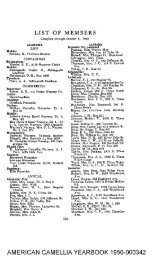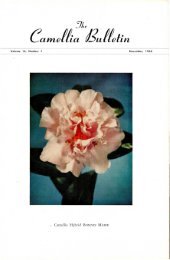CAMELLIA JAPONICA - GOVERNOR EARL WARREN - Immense ...
CAMELLIA JAPONICA - GOVERNOR EARL WARREN - Immense ...
CAMELLIA JAPONICA - GOVERNOR EARL WARREN - Immense ...
You also want an ePaper? Increase the reach of your titles
YUMPU automatically turns print PDFs into web optimized ePapers that Google loves.
a balance of calcium, magnesium and<br />
sodium salts, which are beneficial to<br />
plant growth when in proper balance.<br />
This balance of salts makes it possible<br />
for the water to penetrate the<br />
soil mass more freely and assist in<br />
performing its function in plant<br />
growth, that is, carrying plant food in<br />
solution so that it is available for use<br />
by the plant.<br />
The process of keeping potassium,<br />
sodium and calcium salts in balance<br />
is even more essential in container<br />
culture than when camellias are<br />
planted in the ground. In California,<br />
most of our domestic water supplies<br />
come from melting snow and from<br />
rain water, stored in dams, which<br />
contain very few minerals. Usually<br />
these waters contain a high percentage<br />
of sodium salts, and may reach a<br />
concentration toxic to plants. Even at<br />
low concentrations they cause deterioration<br />
of the soil structure, and<br />
with constant use, the surface of all<br />
but extremely sandy soils will seal<br />
and prevent the wetting of deeper<br />
layers. (]) To counteract this condition,<br />
Gypsum is applied to effect a<br />
chemical reaction as described above.<br />
In using either of the above formulas<br />
for repotting, no further fertilizing<br />
need be done during the first year<br />
after repotting.<br />
The preferable time for repotting is .<br />
from November through April. The<br />
months of November through January<br />
are preferable as the plants are<br />
dormant and will develop new roots<br />
which will extend into the new soil<br />
mixture during the winter months.<br />
This will furnish plant food for the<br />
new spring growth and for bud development<br />
during the spring and<br />
summer months.<br />
Watering Large Camellia<br />
Plants in Containers<br />
Large camellia plants should be<br />
watered thoroughly after repotting<br />
and thereafter about once a week if<br />
the weather remains dry. During the<br />
winter months no watering is necessary<br />
unless prolonged dry and frosty<br />
Northem California Camellia Society 21<br />
weather prevails. During such periods,<br />
water as required, based upon<br />
the moisture content of the soil in the<br />
containers.<br />
During normal spring and summer<br />
weather, water once a week. During<br />
dry, windy weather or exceedingly<br />
hot days, it may be necessary to<br />
water twice a week or oftener. Soil<br />
moisture content and the condition of<br />
each individual plant should be considered.<br />
Fertilizing<br />
Large camellia plants should be<br />
fertilized at the end of the first year<br />
following transplanting to a larger<br />
container. For bloom development,<br />
apply the first feeding of powderform<br />
acid-fertilizer during the month<br />
of December. This application also<br />
stimulates storage of energy in the<br />
stems to support new growth during<br />
the following spring. The same procedure<br />
applies to large plants that<br />
have been in the same size container<br />
for longer periods than one year.<br />
The amount of fertilizer applied for<br />
the winter feeding should be about<br />
one-half the amount prescribed below<br />
for the spring feeding.<br />
In the spring a second application<br />
of powder-form acid-fertilizer, such as<br />
R.A.C., should be applied about the<br />
first of March. I have found the following<br />
amounts of fertilizer sufficient<br />
for healthy plant growth and bud development:<br />
1. Two tablespoons for 30 to 36-inch<br />
bushy plants in 5-gallon containers.<br />
.<br />
2. One tablespoon for 18 to 24-inch<br />
bushy plants in 2 to 3-gallon containers.<br />
3. One teaspoonful for plants in gallon<br />
containers.<br />
The plants should be watered two<br />
days before applying fertilizer if not<br />
previously moistened by recent rainfall.<br />
Immediately following the application<br />
of dry fertilizer the plants should




